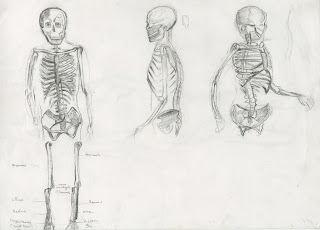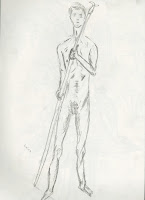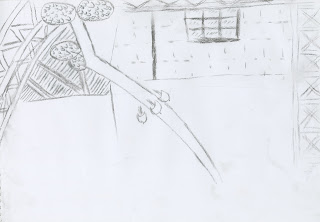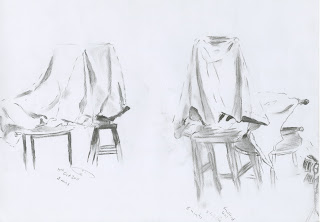Thursday, 26 April 2012
Monday, 9 January 2012
Week: 9 Human Anatomy
Here is series of quick thumbnail sketches basic human anatomy proportion Its the image the book by Tom, R. (1988) about learning skeletal structure, I started with the skeleton and how it is put together. took me around 35 mints using different pencils . its seems that anterior front view and lateral side
Sunday, 8 January 2012
Huddersfield Landscape
This was a landscape in Huddersfield, which took me 2 hours, using watercolour paint. I used a lot of impressionist techniques for the flowers, grass, buildings, trees, and water. I took a photograph of the landscape, and painted from it at home.
Week: 12 Life Draawing and Basic Human Anatomy

Here is a 10 minute life drawing and basic human anatomy session about the posture and pose, balance, weight and gesture using charcoal. The construction line has been used to express a solid human form. In planning, I didn't measure, so the proportion between his spine and his leg was warped; the spine became longer and the legs shorter in order to fit the space. In addition, the lack of measurement meant that I could not find the appropriate size and shape for the circular table. also the image shows had little passive area missing.


Directed Study: Still Life Drawing
This is still life drawing of the Kurdish Traditional Dancing by Bradford Refugee Week, Its took me 30 mints. Location Bradford setsquare.
Directed Study: Self Drawing
This is my first still-life self-portrait, which took me ten minutes. Sorry about the modest covering. You can also see the lamp.
Week: 11 Life-drawing and Basi Human Anatomy
We started in this life-drawing and basic human anatomy in 30 second quick-draw human movement. It is dramatically not easy to get everything dawn on sketch , in this image shows you 20 second human body, I was not happy, But the second image I worked dynamically to get much information dawn from human actions movement. End up I learned how to quick blind draw also.
Week: 9 Life Drawing and Basic Human Anatomy

Here is first life drawing human anatomy completed body, in the pose and proportion drawing was very fast movement from Leslie , its scientific. it was going from linear. I created basic anatomy proportion, I have been learned how character be cycling or moving also how to balances . I finished spine and shoulders on 5 second and on 10 second It was finish all the body but without details.
Week: Bradford and Whitby Landscape
This is Whitby, where are department went on a study trip. We were drawing on the top of the mountains to the right of Whitby looking down upon the lighthouse. Because I didn't have my sketchbook with me, I drew it on a normal A4 page and reproduced it when I returned home. I used charcoal paint. The stormy sky is reflected in the waves smashing horizontally into the coastline marked by greys and red flowers. I used the rule of 2/3s, and the rough lines draw your attention from the bottom left out to the upper right.
Landscape
This was a 40 minute life drawing, which I completed on my first attempt. It is behind the Student Central of the University of Bradford. Because the drawing had a lot of detail, I used impressionist techniques to accurately achieve that effect. I focused my attention on the kissing trees and the lamppost; I had to use an 8B to achieve the appropriate darkness. I think that I successfully achieved a picture that portrays a realistic morning landscape.
Week: 3 Composition

This is a 35 minute still-life composition finished piece. It is about the plan, placement and arrangement. It was my last attempt a live draw, and it was completely different from my previous work; it doesn't even share proximate similarities. In the final work, the drawing's surface grew spontaneously as it progressed. The sketch is composed of both positive and negative shapes. The objects on the table and in the background all react to light differently with transparent, shiny , and shaded surfaces. In addition, the drawing has a distinct dark side.
There is a huge reflection in the vase, and the composition reveals rough and hard surfaces especially in the smaller objects. Along with the rough and hard surfaces, I also produced a smooth surface with a curved line. I really like the lips different angles; it's fluid and draws attention to the variation in the lips vertically, horizontally, and diagonally. Using charcoal, it's difficult to control the lips.
Week:6 Still Life-Natural and Man-made Forms

I produced this sketch in 35 minutes after two five-minute planning sessions. I used mainly charcoal with hard pencil for the shadow. The position I was sitting in was of a high quality because I had a good vision of all the small subjects and their relationship to each other. Due to this position, I had high expectations for my achievement.
The value in this sketch are the small details, some of which I noticed after the planning stages. The objects were all related; you can see the visual effect created by my attention to particular flowers which were higher than others casting shadows from their particular positions. I also concentrated on the background, which consists of Kim, our classmate in computer animation and special effects, drawing. The sketch has an inherent balance: between the top and the bottom, between the textured and the smooth, and between the shiny and the dull. The directional light sits behind the flowers focusing on the balance between the table and the vase.
Week: 1 Simple Practice Drawing-Beginner Drwaing Session
Here is quick study of the first observational drawing module. had started with several straight vertical lines like a square, horizontal lines and repeated, as you probably know, the vertical lines in the image are all the same length, but they do not look that way. the some of the lines looks shorter than the others, and about that the squares of straight diagonal lines? To me it looks the same length as the first the square straight vertical lines.
I started to draw spiral with dimensional line from inside of the spiral to the right, the second and third it seems changed, also there are different shading techniques in the squares such as cross hatching and hatching, I use different type of pencils to grade hardness and softness.
Week
These are six different angles of composition from different parts of Richmond Building. It was the result of 20 minutes of practice on composition. The angle of the ceiling beams in the transparent roof provide strong lines of light creating a focal point. The middle ground of the Atrium creates a stage for the cafeteria. The ground floor portrays the students chatting using the rule of thirds. I used a 6B for the ceiling lights.
Week 4
This was a 25 minute still-life drawing. It was my third attempt after drawing two from various other angles. The first two attempts, I similarly created tonal value with some hard lines, but this attempt was very successful. Because I was using charcoal, I was really interested in using smudges to create the shading and lighting in this piece. You can see the shadows created by two different lamps, but their light isn't strong because of the ambient daytime light. The main light was set up in the right corner making the brightest side of the objects on the left and the darker side on the right. Because I used charcoal, I couldn't use hitching or cross-hatching to create a determent gradient, so you cannot see the lines from multiple directions.
Landscape
I really like this 35 minute still-life architecture drawing session behind Horton and Chesham buildings. I attempted to portray it from a different angle to show a two point perspective. My first planning stage used light lines drawn by a 2B pencil; however, afterwards I changed to using charcoal. I didn't realise that you cannot use pencil with charcoal.
My attention focuses on the shadow of the windows; I used faint horizontal lines to bring life to the windows. This focal point is smack dab in the middle of my composition. Another interesting point is values of the single road and the window on top of Horton building created by dark lines.
Direct Study Week 3
This is a 25 minute still life finished piece. I used pencil to give a one point perspective. It depicts the second floor of the Horton building. It draws attention to the focal point smack dab in the middle of my composition. Also the shading of the rough edges become more detailed as it approaches the focal point. Because the focal point is centered in the middle of the composition, it looks static and boring; moving it to split the composition into thirds is more dynamic.
Subscribe to:
Comments (Atom)




































